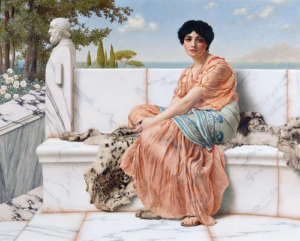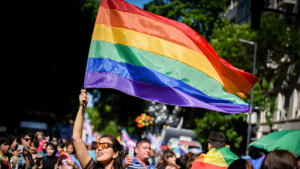Language, Lavender, and the LGBTQ+ Community
The LGBTQ+ community has had to create several ways of expressing their pride in a society that does not value it.

LGBTQ+ people have had to find secret ways to tell others about themselves.
February 28, 2023
Throughout history, people who identify as part of the LGBTQ+ community have had to navigate how to live in a society that doesn’t accept them. In order to find those similar to them, they’ve had to create signals to show their identity in a subtle way. This includes clothing and accessories, language, and even certain flowers.
Fashion played a significant role in LGBTQ+ history, especially in signaling. According to glbtq Archives, gay men would dress more feminine in order to signal their sexuality, and lesbians dressed in more masculine clothing. However, wearing clothing that was designed for women as a man would have been dangerous. Of course, these signals changed as society did. Gay men started wearing more masculine clothing. Handkerchiefs worn in back pockets were a common way to signal for men, with different colors signaling different identities. Some lesbians dressed more masculine in order to signal. A key ring on the belt and carabiner clips are key symbols to lesbians. Women would also paint their nails in order to signal their queerness where, similar to handkerchiefs, different colors signified different identities. According to Syracuse University, Doc Marten boots became a popular way to signify sexual orientation during the gay liberation movement. Fashion has always been a way to explore identity; however, for queer people during times where it was unsafe to openly display their sexual orientation, it was vital to use clothing and accessories in order to subtly code their preferences.
From slang words and secret phrases to even actual languages, queer people found ways to communicate with each other secretly to protect themselves. These languages and slang are called lavender languages. In the United Kingdom, Polari (a form of slang) was used to signal queerness or allyship. According to LGBT+ Cultural Heritage, the gay community in the Philippines speaks Swardspeak, also known as gayspeak. Other languages used were Lubunca, Isingqumo, and Gayle. Also common were phrases to figure out whether someone was also gay. According to RTE, a common phrase used was a “friend of Dorothy,” most likely based on Dorothy from “The Wizard of Oz.” People may also make references to known gay figures; for example, a gay man may make a reference to Oscar Wilde. An example from recent years is asking someone if they listen to girl in red, a popular queer singer-songwriter.
There are several flowers that are significant in the LGBTQ+ community. According to Flower Power Daily, green carnations became a symbol for gay men when Oscar Wilde popularized it in 1892 by encouraging his friends to wear them to his comedy, “Lady Windermere’s Fan.” Violets became a symbol because Sappho, a Greek poet, referenced them in her poems, associating them with female love. Pansies, roses, and tie-dyed roses are also symbols of the LGBTQ+ community. Lavender is a very important symbol for both gay men and women. Flower Power Daily states that “lavender boy” was used to describe gay men in the 1920s. Lavender became linked with lesbians being included in the women’s movement. Lesbian feminists wore shirts saying “Lavender Menace.” The Lavender Scare, similar to the Red Scare, was the panic about gay people in the U.S. government and happened near the same time as the Second Red Scare. Many of these flowers have significant meaning to members of the LBGTQ+ community; although, to those who don’t know the history behind these, they are just plants.
There are many ways that queer people have signaled to each other and created safe spaces throughout history. These effects are seen today in modern fashion and language. This includes wearing pride pins or wearing clothing, accessories, makeup, or nail polish in colors of pride flags. It could be wearing clothing that is gender androgynous or commonly worn in queer communities. Flagging is an incredibly important way for queer people to signal to each other without actually having to “come out of the closet” and will remain a key way for queer people to find each other and maintain safe spaces.











